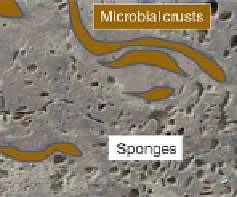Geoscience Reference
In-Depth Information
Sponge-rich element
Bioclastic element
Log data
1cm
Porosity from logs
(minus the separate
vug pores)
Effective perm from
'sponge-rich' REV
Perm from core
plugs
bioclastic
sponge-rich
Platform margin REV
BASIN
PLATFORM
20m
500m
Model over full volume of interest
Fig. 6.42
Workflow for modelling pore-scale detail in a
larger scale carbonate model for a platform margin.
Top
:
pore scale elements, the REV for one of which is captured
at the core plug scale, the other requiring effective property
modelling to quantify;
middle
: outcrop analogue guiding
the concept for architectural arrangement of elements
within a layer, the second REV scale;
lower
: sequence-
based framework showing the location of the sponge-
dominated REVs, scale informed from the work of Leonide
et al. (
2012
). Porosity is modelled directly from logs
onto a large-scale chronostratigraphic framework
such as that in Fig.
6.41
. In a clastic reservoir the
route would be via depositional architecture
(facies, facies associations), but this only applies
to carbonates at one tip of the ternary set of
influences (Fig.
6.40
). Even then the task remains
of finding the REVs for the intermediate scales
between pore and region. Carbonate modelling
requires the integration of all three nodes of the
ternary in Fig.
6.40
, encapsulating the model
purpose (Chap.
1
) and the scale at which the
model purpose applies, which usually relates to
the current and planned well spacing.
These issues have been further explored in
recent studies (e.g. Kazemi et al.
2012
) which
relate to the hierarchies of REVs (described in
Chap.
4
). An example of how this can be done is
shown in Fig.
6.42
, working up from the pore



























